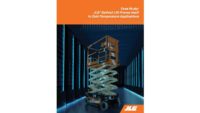Project Challenge:
The Vail Mountain View Condos, a beautiful new residential development located in the coveted Vail Village, was built using energy-efficient building products from Atlas Roofing Corporation. It is the first major development in the village in over a decade. The luxury, multifamily building includes nine residences and six penthouses that range in price from $7.4 million to $9.6 million and are designed for the highest levels of energy efficiency, meeting industry-leading sustainability standards. This means the building has to manage the cold and heavy snow in the winter and the heat and high-altitude sunshine of summer incredibly well.
Once the architecture, design and build team decided on their construction materials and plan, they faced multiple challenges during the project build. Because of permitting and other logistics, the roofing portion of construction had to begin in January 2021, during the height of the pandemic. The five-story residential building needed to be completed within a year and there was no time to delay the installation of the roofing system until spring. The team needed to be meticulous in the execution and the building materials had to meet the stringent requirements of the task. The roofing contractor, Jeff Johnston, president of The Roofing Company, needed a trustworthy manufacturer with great customer service, high-performing building products and a company that could deliver the products on time.
Approach:
All building products selected for the project were extremely important to meet the high-performance and energy efficiency needs of the harsh Vail climate. Atlas ACFoam CrossVent was selected as a critical part of the roof system for the performance benefits of combining a cross-ventilating air space, nailable roof substrate and thermally efficient continuous insulation. It provided both insulation and above deck ventilation for the roof, which is essential for this type of project in this climate. The Atlas ACFoam products are designed to seamlessly work together as part of an efficient and fully functional nailable roof system.
“ACFoam, and especially ACFoam CrossVent, are our go-to products and Atlas is one of the only manufacturers we can depend on to get us their product when we need it,” said Jeff Johnston, owner of The Roofing Company. “We needed a solution that not only met an R-value of 20 on the roof but also provided a fully continuous insulation solution. We’ve always had success using the Atlas products, so it was a natural solution for this high-profile project.”
More than 210 squares of Atlas ACFoam and ACFoam CrossVent were installed on the roof. Using a base layer of ACFoam under the ACFoam CrossVent insulation, with staggered joints, provided the desired higher R-value to mitigate undesirable heat loss, which is crucial in heavy snowfall climates like Vail, Colorado. Inadequate roof insulation and ventilation in a region like this can create major ice damming on roofs, which results in costly maintenance fees and/or expensive repairs down the road. ACFoam CrossVent utilizes high compression resistance vent spacer strips that allow for multi-directional ventilation, while giving maximum area for mechanical attachment. The vent spacer strips are available in 1-inch, 1.5-inch and 2-inch thicknesses to allow for the appropriate ventilation for your project and to create a self-sustaining positive flow of air through the roofing system. Jeff Johnston recommends his clients use Atlas ACFoam for its consistent performance and quality.
Safety was paramount for the installation crew and the greater Vail community during this winter project. As the crew members battled ice and snow during the extreme weather conditions, the team continued forward, even when it meant a total of 280 hours of shoveling snow from the roof. Also, because the project was a mere 100 feet from Interstate 70, there was zero tolerance for loose objects flying off the roof and potentially injuring workers or motorists on the highway. All material needed to be secured to the roof deck using a combination of webbing and metal wiring.
Result:
The roof project using ACFoam CrossVent was installed successfully and continues to perform the way it was designed, providing the insulation and ventilation needed to maximize energy efficiency inside the building, as well as reduce snow and ice buildup on the roofs. The Atlas team is extremely knowledgeable when it comes to building science, especially in the extreme weather of this climate zone. They have assisted on many projects to help educate community leaders and residents on the product’s benefits and value as well as attended local HOA meetings to explain the design and efficiency benefits. The ability to be able to vent properly is critical for the performance and longevity of any building project, but especially on a steep slope roof in this climate zone. In the end, a challenging installation was overcome, and the roof can easily handle everything Vail Mountain weather can throw at it in a low-maintenance, energy-efficient manner. The added benefit for residents is the energy efficiency of their homes, using less energy to heat and cool their homes, and making their homes more comfortable year-round.



Report Abusive Comment